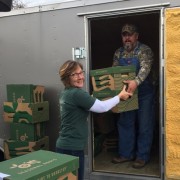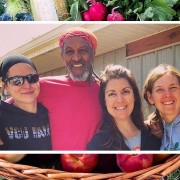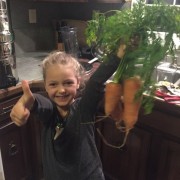By the Seasonal Roots Veggie Fairies:
If you make a New Years resolution to eat local, sustainably produced food in 2017, you won’t just live better – you’ll actually help change the world. So without further ado, here are the top 10 ways this one simple New Years resolution will change you and your world. (Just wait till you get to #1!)
Resolve to eat local, sustainably produced food, and you will…
#10:
…waste less of everything, including time.
The short distance between a local farm and you means less storage, no middleman, and that means less wasted food and packaging. And with home delivery from an organization like Seasonal Roots, you’ll save time, too.
#9:
…relax and enjoy the view.
Use some of that time you save to relax and enjoy the open space you’ll be helping preserve. That’s because buying local food saves nearby farms from getting turned into yet another suburban development. Since our farmers use sustainable methods (unlike factory farms that plant miles and miles of monocrops), our farmers create ecosystems that are good for the soil, water, and air, a rich patchwork of fields, meadows, woods, and ponds – the perfect habitat for wildlife and a peaceful space for recreation.
#8:
…reduce unemployment and taxes in your community.
When you buy local, your food dollars stay in your community instead of going to some faraway corporate headquarters. Buy local food and your dollars create jobs at local farms, food processing facilities, and distribution systems. Plus, studies show that, compared to development, farms contribute more in taxes than they require in services. Chickens don’t go to school and rutabegas don’t call 911. That helps keep taxes from going up.
#7:
…achieve peace of mind.
Local food is safer and more secure. You’ll get to know the farmers who are growing and handling the things you eat. They’re not anonymous, and neither are you, and our farmers take that relationship seriously as they grow and handle your food. Plus, if there’s ever a breakdown in the global food system – which relies on fossil fuels to produce, package, store, and distribute food – your local farmers will still be here, still supplying you with safe, fresh food.
#6:
…eat more delicious food.
Most Seasonal Roots food comes from farmers and artisans within 150 miles (one-tenth as far as supermarket produce). Because local food doesn’t travel very far, farmers can grow varieties for their flavor, not for shelf life and ability to withstand getting drop-kicked halfway around the world. And since the stuff our local farmers grow will be eaten in days instead of weeks, it can be picked at the peak of ripeness — mmmmm. As for locally made products like cheese, bread, and coffee, they’re handcrafted for best flavor and not pumped full of preservatives and artificial flavors.
#5:
…be super cool.
Compared to the global industrial food complex, food from local farmers and artisans uses less fuel and produces less CO2 – 17 times less! So local food belches fewer greenhouse gases and fights global warming. That’s cool.
#4:
…support family farms.
Our family farmers treasure the land as a legacy for their children. They farm with future generations in mind, not short-term profit. That’s good for all of us, for all the reasons listed here.
#3:
…be kind to animals.
Unlike factory farms, our family farmers raise their animals humanely. Chickens, cows, goats, and pigs live happy lives in open pastures. It’s good for the animals, who don’t need constant antibiotics and hormones to grow and stay healthy, and good for us people, too. Grass-fed meat, milk, and eggs are much more nutritious than the conventionally produced kind.
#2:
…get healthy.
Fresh, local, sustainably grown food is better for you. Take meat, dairy, and eggs from animals raised sustainably on pasture. Grass-fed beef, for example, is higher in “good” cholesterol (and lower in “bad”) than factory farmed beef. Grass fed dairy is higher in vitamins A and E, lower in fat, and contains more antioxidants. As for produce, as soon as you pick it, it starts to lose nutrients. So Seasonal Roots delivers it to you within 48 hours, dirt to doorstep™. (Supermarket produce is typically a week old and has lost almost half its nutrients before you even get it home!) Sustainably produced food also means less (or no) agricultural chemicals (such as pesticides), antibiotics, or hormones.
#1: (Drum roll, please…)
…bring more love and joy into your life!
Resolve to buy local, sustainably produced food and you will have a powerful tool for strengthening all the loving relationships in your life. Let’s say you get a passle of local peaches, so fresh and ripe you can smell them, and you remember the peach pie your grandmother used to make when you were a kid, and you get totally inspired and dig out that recipe and call in the kids. Together you whip up a couple of pies while you tell them stories about your late great granny. Then Mr. Grumpy Pants from next door marches over to complain about the noise of happy children – but you offer him a piece of pie and a strange look comes over his face, and you realize that strange look is a smile, and you get to know each other while eating delicious pie to the sound of the laughter of children. And isn’t that what life is all about?
The Veggie Fairies at Seasonal Roots wish you a happy, healthy New Year!
Share the veggie love with someone you care about! 10% off Seasonal Roots Gift Cards if you order by January 2 — give the gift of living better. Just send us an email with your phone number and best time to call to arrange credit card payment, and we’ll set you up with all the Gift Cards you need.









